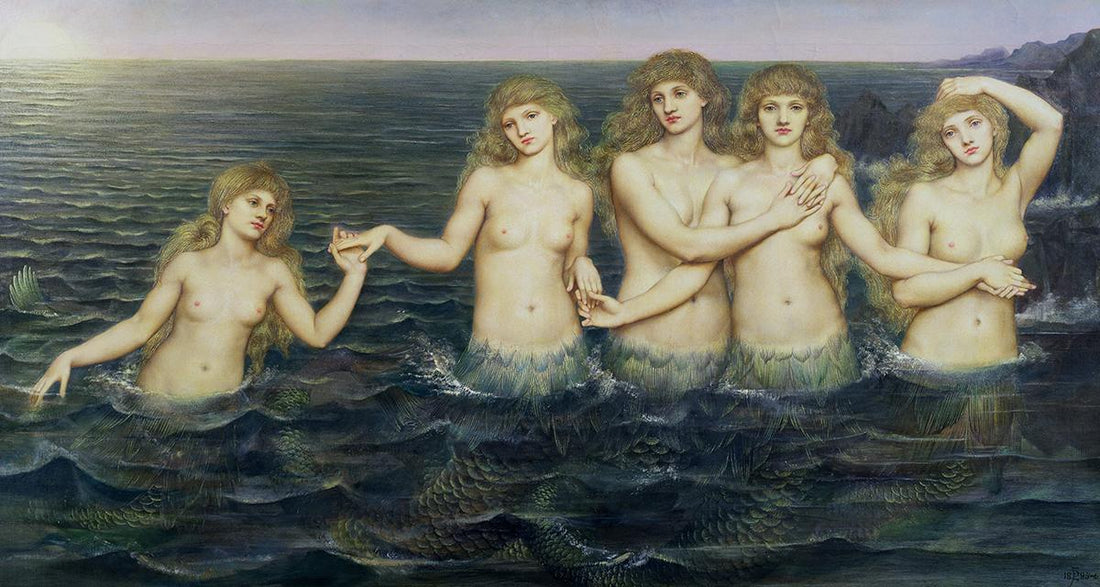Mermaids are majestic, mysterious, and beautiful sea creatures that inhabit our oceans; for thousands of years, they’ve captivated the imagination. Centuries of intrigue have inspired many different adaptations of mermaids in pop culture and classical art. Contemporary mermaids are often depicted as female creatures longing to break free of their oceanic prisons. Movies such as Splash (1984), Disney’s The Little Mermaid (1989), and Aquamarine (2006) all depict mermaid heroines desperately yearning for the human world, often because they’ve fallen in love with a human man. These films reinforce misogynistic cultural norms by praising women who abandon their own agency and change for a man they think they love. This somewhat problematic interpretation of mermaids, however iconic and endearing, is thankfully not the only representation of these creatures available.
Classical art mermaids, conversely, are depicted as seductive and villainous sirens, whose irresistible songs lure in unsuspecting fishermen and sailors, sending them to their watery graves. Artists have traditionally painted mermaids with long hair, fair skin, shimmering tails, and bare, topless torsos. In the paintings, the mermaids brush their curls alongside their sisterly companions, as they plot to drown their next male victim. Greek mythology inspired these depictions in classical art, where mermaids were conceptualized as mythological creatures called sirens. The role of these sirens was to lure men to their deaths with their sweet songs. In classical literature, mermaids make an appearance in Homer’s The Odyssey and Hans Christian Andersen’s The Little Mermaid. These works challenge the 20th-century version of mermaids of our childhoods, who wish to be “part of our world.” To investigate these interpretations further, we can take a closer look at some famous paintings of mermaids from the 19th and 20th centuries.
An influential female artist who depicted mermaids was Evelyn De Morgan. She was an English artist who painted The Sea of Maidens, an oil on canvas completed in 1886, which was influenced by the stylings of Pre- Raphaelites. Her painting closely follows Hans Christian Andersen’s The Little Mermaid.
De Morgan painted the five sisters standing up for their younger sister, the titular little mermaid. The sisters have fair skin, and exposed breasts, and are holding hands in solidarity. Their tails ripple underneath the ocean’s surface. De Morgan never painted any of her subjects “in danger, trapped and waiting to be rescued.” Rather, she wanted the mermaids “to have ownership of themselves, not falling into archetypes of passivity.”
John Williams Waterhouse, an impressionist artist, established himself as the godfather of mermaid paintings at the turn of the twentieth century. He had a huge fascination with mermaids, so most of his classical artwork depicted their simultaneous capacity for beauty and deception. A Mermaid was more than likely inspired by the poem “The Mermaid” by Alfred Lord Tennyson in 1830. In this painting, a lone mermaid is seen sitting on a rock, brushing her hair, and looking out into the distance. In fact, some art critics believe the pearls inside the seashell beside the mermaid are “formed from the tears of dead sailors.” Thus, the painting of this beautiful mermaid brushing her hair manipulates the viewer with her secret deadliness. The painting was first exhibited at the Royal Academy in 1901 after Waterhouse was elected as an Academician.
Another of his works, The Siren, depicts a siren in action. Seated on a rock, playing the lyre, she looks down at a man floundering in the ocean. Art historians note that “she is in the process of the transformation into a mermaid, the lower parts of the legs are turning into fish scales and fins.” The siren has auburn hair, which “became an attribute of the femme fatale in the 19th century.” The fate of the lone and scared sailor in the ocean is unknown, but considering what sirens were known for, the sailor has every right to be afraid.
Herbert James Draper, an English painter who painted during the Victorian and Edwardian eras, took inspiration from Waterhouse’s work when creating Ulysses and the Sirens. The painting, completed in 1909, depicts the iconic scene from Homer’s The Odyssey.
The painting portrays “a boat full of muscly sailors apparently terrified by three nude girls. As they climb aboard, an act of assertive sexuality, the sirens change into women.” A woman in the ocean still has a mermaid’s tail, and another, who’s climbing into the boat, has human legs. The women are fair-skinned and t fully nude. Draper has sexualized the women. According to the Victorian Web, “The theme of manly- self-control, emphasized by the brawny physiques and steely expressions of the crew, is played off against the idea of female sexual danger epitomized by the pale glistening bodies of the agile girls who clings seductively to the side of the boat.” The audience of this painting is clearly male, exemplifying hyper-masculine norms of self-control, and casting women as sexual temptresses.
Paul Delvaux, a surrealist artist from Belgium, was known for painting dreamlike sequences. The Villages of the Mermaids, completed in 1942, is confusing at first glance. The scene portrays a group of women donned in floor-length dresses, sitting down outside a building. The women sit in a row that extends out into the ocean in the background. A man dressed in black is seen walking away from the woman towards the ocean. On the beach lies a group of nude mermaids. To help understand this surrealist painting, consider the following analysis: “ To him (Delvaux), maybe they aren’t just the same dull person but extraordinary in some way, like one imagines a mermaid to be.” Unlike traditional sirens, the women aren’t seducing anyone, nor are they painted as stereotypically beautiful and seductive creatures. Rather, it “seems somewhat dreary and cold using words such as ‘gray’ and ‘dusky.’”
During the nineteenth and twentieth centuries Evelyn De Morgan, John William Waterhouse, Paul Delaux, and Herbert James Draper painted mermaids as mysterious and villainous sirens. The artists were inspired by Greek mythology such as Homer’s The Odyssey and Hans Christian Andersen’s The Little Mermaid. However, the interpretation in classical art is by far different from contemporary mermaids shown in Disney’s The Little Mermaid (1989). The difference between classical art versus contemporary movies is how these historical beings had their whole image reimagined. Disney had completely changed the ending for The Little Mermaid from its original story. Instead of turning into seafoam, Ariel, who desires to be “part of our world,” tosses aside her life under the sea and marries Prince Eric. Little does the audience from the 20th century, who’ve grown up with Ariel, realize classical art has depicted mermaids as villainous sirens who lured men to their deaths with their song.
©ArtRKL™️ LLC 2021-2023. All rights reserved. This material may not be published, broadcast, rewritten or redistributed. ArtRKL™️ and its underscore design indicate trademarks of ArtRKL™️ LLC and its subsidiaries.










